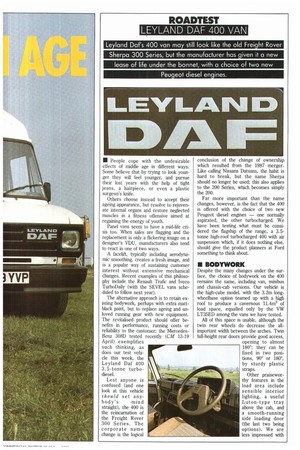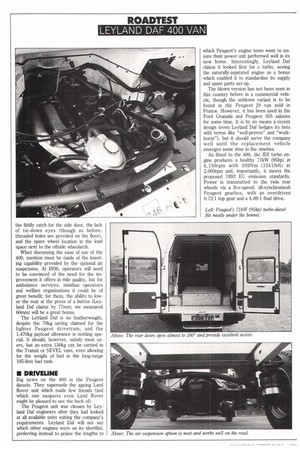ILIElfrL."111S1
Page 35

Page 36

Page 37

Page 38

If you've noticed an error in this article please click here to report it so we can fix it.
ICOAPX
• People cope with the undesirable effects of middle age in different ways. Some believe that by trying to look younger they will feel younger, and pursue their lost years with the help of tight jeans, a hairpiece, or even a plastic surgeon's knife.
Others choose instead to accept their ageing appearance, but resolve to rejuvenate internal organs and restore neglected muscles in a fitness offensive aimed at regaining the energy of youth.
Panel vans seem to have a mid-life crisis too. When sales are flagging and the replacement is only a flickering image on a designer's VDU, manufacturers also tend to react in one of two ways.
A facelift, typically including aerodynamic smoothing, creates a fresh image, and is a popular way of sustaining customer interest without extensive mechanical changes. Recent examples of this philosophy include the Renault Trafic and Iveco TurboDaily (with the SEVEL vans scheduled to follow next year).
The alternative approach is to retain existing bodywork, perhaps with extra mattblack paint, but to replace ageing and unloved running gear with new equipment. The revitalised product should offer benefits in performance, running costs or reliability to the customer; the MercedesBenz 308D tested recently (CM 13-19 April) exemplifies such thinking, as does our test vehicle this week, the Leyland Daf 400 3.5-tonne turbodiesel.
Lest anyone is confused (and one look at this vehicle should set any body's mind straight), the 400 is the reincarnation of the Freight Rover 300 Series. The corporate name change is the logical conclusion of the change of ownership which resulted from the 1987 merger. Like calling Nissans Datsuns, the habit is hard to break, but the name Sherpa should no longer be used; this also applies to the 200 Series, which becomes simply the 200.
Far more important than the name changes, however, is the fact that the 400 is offered with the choice of two new Peugeot diesel engines — one normally aspirated, the other turbocharged. We have been testing what must be considered the flagship of the range, a 3.5tonne high-roof turbocharged 400 with air suspension which, if it does nothing else, should give the product planners at Ford something to think about.
Despite the many changes under the surface, the choice of bodywork on the 400 remains the same, including van, minibus and chassis-cab versions. Our vehicle is the high-cube model, with the 3.2m longwheelbase option teamed up with a high roof to produce a cavernous 11.4m3 of load space, equalled only by the VW LT35ED among the vans we have tested.
All of this space is usable, although the twin rear wheels do decrease the allimportant width between the arches. Twin full-height rear doors provide good access, opening to almost 180'; they can be fixed in two positions, 90° or 180°, by sturdy plastic straps.
Other praiseworthy features in the load area include sensible interior lighting, a useful Luton-type tray above the cab, and a smooth-running side loading door (the last two being options). We are less impressed with the fiddly catch for the side door, the lack of tie-down eyes (though as before, threaded holes are provided on the floor), and the spare wheel location in the load space next to the offside wheelarch.
When discussing the ease of use of the 400, mention must be made of the kneeling capability provided by the optional air suspension. At £936, operators will need to be convinced of the need for the improvement it offers in ride quality, but for ambulance services, minibus operators and welfare organisations it could be of great benefit; for them, the ability to lower the rear at the press of a button (Leyland Daf claims by 77riun; we measured 60nun) will be a great bonus.
The LeViand Daf is no featherweight, despite the 70kg saving claimed for the lighter Peugeot drivetrain, and the 1,470kg payload allowance is nothing special. It should, however, satisfy most users, but an extra 150kg can be carried in the Transit or SEVEL vans, even allowing for the weight of fuel in the long-range 105-litre fuel tank.
Big news on the 400 is the Peugeot diesels. They supersede the ageing Land Rover unit which made few friends (and which one suspects even Land Rover might be pleased to see the back of).
The Peugeot unit was chosen by Ley-' land Daf engineers after they had looked at all available units suiting the company's requirements. Leyland Daf will not say which other engines were on its shortlist, preferring instead to praise the lengths to which Peugeot's engine team went to ensure their power unit performed well in its new home. Interestingly, Leyland Daf claims it looked first for a turbo, seeing the naturally-aspirated engine as a bonus which enabled it to standardise its supply and spare parts set-up.
The blown version has not been seen in this country before in a commercial vehicle, though the unblown variant is to be found in the Peugeot J9 van sold in France. However, it has been used in the Ford Granada and Peugeot 505 saloons for some time. It is by no means a recent design (even Leyland Daf hedges its bets with terms like "well-proven" and "workhorse"), but it should serve the company well until the replacement vehicle emerges some time in the nineties.
As fitted to the 400, the IDI turbo engine produces a healthy 71kW (95hp) at 4,150rpm with 209Nm (1541lbft) at 2,000rpm and, importantly, it meets the proposed 1992 EC emission standards. Power is transmitted to the twin rear wheels via a five-speed, all-synchromesh Peugeot gearbox, with an overdriven 0.72:1 top gear and a 4.89:1 final drive. To those used to the Sherpa, the performance of the turbocharged 400 will be a revelation, the sensation probably being something akin to that felt by a dog finally being let off the lead. To those used to turbo-diesel power, such as is offered by the Fiat Ducato or Talbot Express, the experience will be nothing new, but nevertheless still enjoyable.
Around our light van test route, the 400's impressive mid-range urge could be used to great advantage, and it powered up the M20 hillclimb in fourth gear a minute faster than the previously-tested Sherpa 350 to equal the Talbot and Fiat at a little over three minutes.
Leyland Daf sees the typical turbo customer as someone who requires a van capable of high-speed motorway work, and the 400 acquits itself well in this role, humming along smoothly at the legal limit. We found refinement under other conditions to be less satisfactory, despite the full bulkhead fitted in our vehicle. Push the engine a bit harder with large throttle openings and high revs, and the power unit becomes rather raucous, being noisier than the Sofirn engine used by Fiat, for example.
Fortunately, sensible gearing allows a driver to use the lower part of the rev range where the engine is less agitated, although this is not helped by a gearbox whose gate is rather poorly defined.
While the turbo engine undoubtedly provides good performance, its economy is less impressive. Round our test route its laden figure of 14.0lit/100km; (20.3mpg) is marginally the worst of the turbo-diesels so far tested at 3.5 tonnes, compared with, at one extreme, the VW LT35ED (13.71it/100krn; 20.6mpg) and at the other extreme the exceptional Ducato Maxi Turbo D (11.11it/1001cm; 25.4mpg).
Our unladen figure of 10.71it/100km (26.4mpg) compares more favourably, suggesting that operators running with fighter loads, such as parcels should not lose out unduly.
The turbo engine is quite a snug fit under the bonnet, but most important items can be reached without too much difficulty. Major service intervals are 12,000 miles (19,3001cm), although an oil change is specified every 4,000 miles (6,400km).
Perhaps more important for the operator will be the best dealer back-up on this relatively-new driveline — and Ley land Daf will have to make sure that all its LCV dealers are familiar with the Peugeot product. • The handling of the test vehicle was influenced by the rear air suspension, which Freight Rover unveiled at last year's Birmingham Motor Show.
Developed jointly with Aston Martin Tickford and Dunlop, the system is a relatively simple one, featuring quarter elliptical trailing rear arms supporting the Dunlop air bags which are mounted just to the rear of the axle. A panhard rod controls the axle's lateral movement.
Without driving a comparable steelsprung van side-by-side, it is difficult to comment on the precise differences in ride quality. What is clear, however, is that the system provides its cargo — be it human or delicate components — with a level and stable ride, entirely devoid of the harshness usually associated with stiffly sprung metal leaves.
The 400 also benefits from a new variable-ratio steering system which provides good feel at speed, but which moderates the effort when manoeuvring. It is certainly an improvement over the old Sherpa's steering, which needed an arm
wrestler's biceps to master, but it is still a bit weighty at low speed.
Also new is the circuitry used on the brakes, which 'provide an "HI" split, with the primary "H" circuit serving all four wheels, and the secondary "I" circuit the front discs only. Should the primary circuit fail, therefore, the driver still has the use of the more efficient front brakes.
Of more immediate concern to the driver is how the brakes perform on the road. Under normal conditions, the answer is pretty well, with effective braking offered by a progressive pedal with sensible weighting. At the test track, however, we found that the rear wheels locked up under emergency braking, with the van veering off line. When asked for its comments, Leyland Daf put this down to an adjustment problem, stating that the system is designed for front lock-up first.
Our van benefited from the optional HL trim pack, which provides luxuries such as smart velour seat trim, carpeting and a push-button radio. Whether this sort of thing is appropriate for many businesses is another matter, but it certainly provides an excellent driving environment.
• There is plenty of storage space in the cab, while the dash has a small set of clearly marked instruments easily visible through the chunky steering wheel. Most minor controls are to be found on the two steering column stalks; we were particularly impressed with the provision of an adjustable intermittent wipe.
The general quality of fit and finish both inside and out is impressive, with the 400 giving an impression of solidity and durability. Leyland Daf should look out for the details, however, for during a quick examination of the dashboard mouldings, the driver was alarmed to find the dash surround coming off in his hand.
The latest round of changes has certainly given the Sherpa a new lease of life to go with its new name. With Ford still unable to offer a turbo-diesel on the Transit, Leyland Daf has gained a marketing advantage which could enable it to grab back a little market share if it seizes the opportunity.
While slightly noisy when extended, the Peugeot turbo-diesel performs well, with acceptable economy, and is well suited to the motorway life which Leyland Daf is expecting for it.
It should also find favour with continental buyers, who have long preferred diesel engines in their vans.
Given that Leyland Daf attends to the trim detail problems, the new 400 has all the makings of a solid hard-working van. It has been a long time coming, but for many operators the wait may well have been worthwhile.
• by Peter Watt














































































































































































